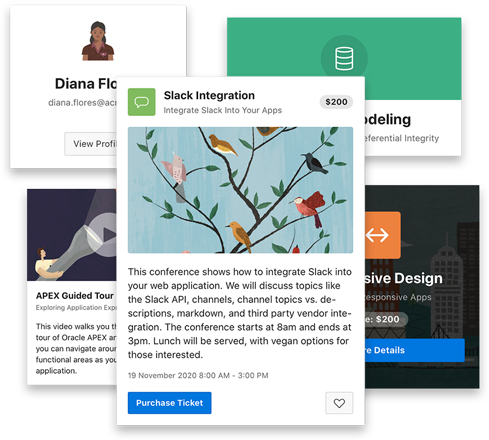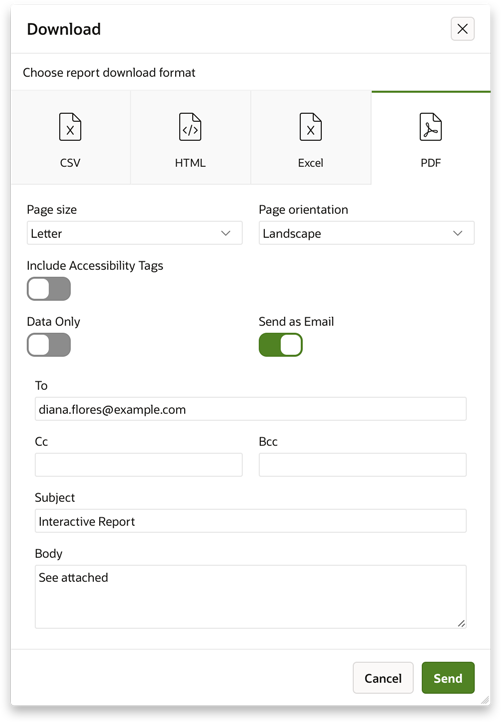What's New in Oracle APEX 20.2
All New Cards Component
The new Cards component unlocks a powerful new way to present data and provides developers with the ultimate control and flexibility over the user interface.
The Cards region provides easy customization of nearly every aspect of the card UI, including the layout, appearance, icon, badge, media, advanced HTML expressions that support client-side templating, and for the first time, the ability to define multiple actions per card. This means that you can include any number of actions, such as links or buttons, on a single card, all without writing a single line of code.
Visit the Cards page in the Universal Theme Sample App, and the Cards Demo App to see Cards in action.
Blog Post: Simple Guide to Cards
Automations
Automations are a conditional set of actions that are automatically triggered by changes that occur within database tables or remote data sources. They are used to monitor data and then perform the appropriate action (examples are auto-approving specific requests and sending email alerts). An automation can be triggered on Schedule or on Demand, by invoking the APEX_AUTOMATION API.
Faceted Search Enhancements
Blog Post: Faceted Search in 20.2-
Bar or pie charts of facet value counts
Quickly display a chart of facet value counts in a dialog or 'dashboard' area.
-
Groups of checkbox facets for Boolean columns
Checking the facet will find records that match the 'yes' or 'true' value of the column.
-
Input Field facet type
Input Field facet type supports comparing a user-entered value with the facet column. This enables faceted searches such as finding stores within a user entered number of miles or records where a column contains the user entered text.
-
Performance optimization for distinct value facets
Report Printing
-
Built-in PDF printing and Excel download
Built-in APIs to print PDF and download Excel in interactive reports and classic reports.
-
Interactive Report - Send E-Mail
All download formats can now be attached.
-
Enhanced integration with Oracle Analytics Publisher
-
New APIs to generate files
Introduced new APEX_REGION.EXPORT_DATA and APEX_DATA_EXPORT APIs to programmatically generate PDF, CSV, Excel, HTML, JSON, and XML files.
-
More language support
Built-in PDF now supports Chinese, Japanese and Korean languages.

REST Data Source Synchronization
APEX supports data synchronization from a REST Data Source (formerly known as Web Source Modules) to a local table. Synchronization can run either on Schedule or on Demand, by calling the APEX_REST_SOURCE_SYNC package. Developers don't need to build custom PL/SQL code in order to copy data from REST services to local tables; APEX provides this as a declarative option.
Blog Post: Synchronize Data from REST-
More control over REST Source Data
REST Source Data can be appended or merged to the local table. Replacing all local data is also supported.
-
Local or REST Source Data
APEX components using the REST Data Source can be configured to use the local table instead.
-
Configure Technical Details
Technical details like HTTP request limits, commit intervals or delete methods for the Replace mode are configurable.
-
Automatic Table Generation
REST Data Source Connector Plug-Ins
The APEX Plug-In infrastructure has been extended to support Connector Plug-Ins for external REST APIs. This enables APEX to fully leverage REST API features like result pagination or server-side filtering, often used with 3rd Party REST Services (note: APEX natively supports ORDS and Oracle Fusion SaaS Services today!)
-
Rest Service Handling
The Plug-In code handles REST service-specific implementation details like the pagination style or how filters are passed to the REST API.
-
Automatically Pass Relevant Information
When APEX invokes a REST Data Source (for example, to render a report), the engine will invoke the Plug-In code and pass all relevant context information.
-
HTTP Requests
The Plug-In code executes one or multiple HTTP requests and passes results back to the APEX engine.
-
Automatic Processing
APEX processes the REST response received from the Plug-In.
New Web Credential Types
APEX 20.2 introduces new URL Query String and HTTP Header types for Web Credentials. This allows developers to use the secure and encrypted credential storage also for REST Services which expect an element (like an API key) as part of the URL. APEX makes sure that such sensitive parts are not written to debug or execution logs.
A web credential can now be protected by providing a URL pattern. APEX will only use the Web Credential for URLs starting with the given pattern; otherwise an error message will be raised. To change the URL pattern, the secret part of the Web Credential needs to be entered again.

Redwood Light Theme Style
Universal Theme now provides a new Redwood Light theme style for your apps, available via Theme Roller. This new theme style aligns with Oracle's new user experience design system, and provides the new design, color, and textures that extend across all of Universal Theme.
Refresh your existing apps to uptake the latest version of Universal Theme and this new theme style.
Developer Experience
-
Multiple Tabs in Property Editor
Page Designer has been enhanced to support multiple tabs in the Property Editor pane, making it more efficient to access the attributes of a region.
-
Monaco Editor
Oracle APEX now uses Monaco Editor to provide a vastly improved coding experience throughout the development environment. The new editor provides in-context code completion, syntax highlighting, and superior accessibility.
-
Inspect the SQL, PL/SQL and JavaScript code with Ease
The Embedded Code utility allows developers to inspect SQL, PL/SQL, and JavaScript contained within an APEX application. Having the ability to view the embedded code makes conducting tasks such as code reviews, security evaluations or application tuning far more convenient. Code can be saved to the file system from the App Builder or using the APEXExport utility.
-
Quick SQL Enhancements
Quick SQL now enables you to save and load data models, provides automatic primary key column defaults, and delivers far better coding experience with improved syntax highlighting and autocompletion for table and column directives.

New and Improved Items
-
New Checkbox
This single checkbox offers an alternative to the Switch item type for Boolean columns. This works in Interactive Grid as well, even when not in edit mode. The previous Checkbox type has been renamed to Checkbox Group.
-
File Browse
File Browse item type has been enhanced to support rendering as a drop zone, supporting the drag & drop of a file to be uploaded.
-
Rich Text Editor
Rich Text Editor item type has been upgraded to use CKEditor 5 and now supports Markdown output.
-
Text Field
Field item type has a new Text Case setting to optionally transform the user-entered text to upper or lower case. The Text Field Trim Spaces and Text Case settings and Textarea Trim Spaces settings are now applied on the client as well as the server.
Additional Features
Below are a number of additional features you should familiarize yourself with.
-
Tree Region Enhancements
Tree region type has been enhanced to support lazy loading and refresh without having to reload the full page.
-
New Interactive Grid Saved Report Static ID Support
Linking to Interactive Grid saved reports should use the saved report static ID instead of the report name. With APEX 20.2, the APEX_IG API has been updated to require using the saved report static ID rather than the report name, when linking to Interactive Grids.
-
Web Source Modules are now named REST Data Sources